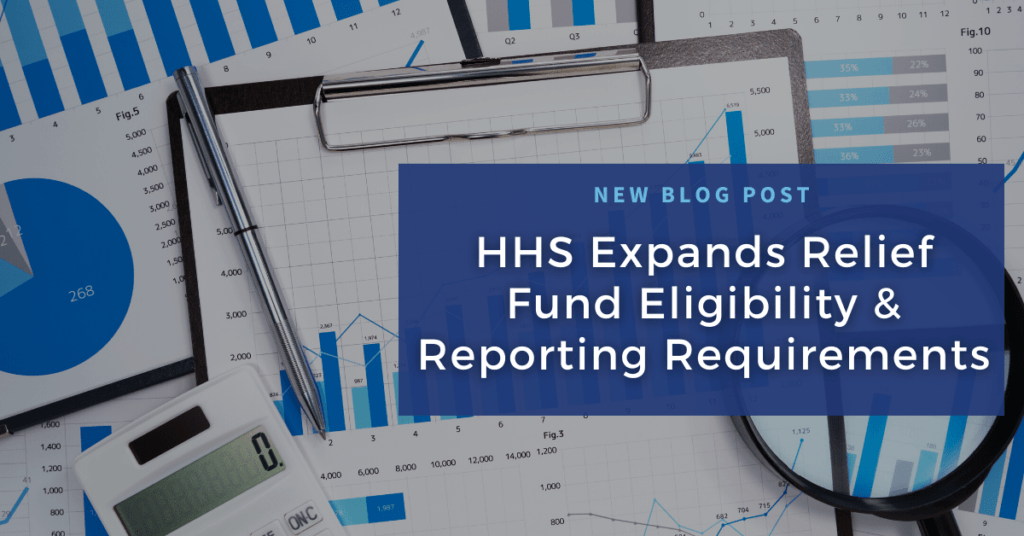The Payroll Relief Fund (PRF) gave providers and hospitals 175 billion dollars to pay for COVID-19 related healthcare expenses,
such as payroll and PPE, and/or lost revenue a lifeline when you needed it, but the relief was not completely free.
Not surprisingly, the government wants detailed reports about how you have used these funds in your practice, and they’ve recently provided supporting information to their Post Payment Notice of Reporting Requirements released in July. To stay in compliance, you will need to adhere to these explicit guidelines. HR for Health wants to help you navigate this reporting process.
Expanded Provider Pool
In the latest update, Health and Human Services (HHS) expanded the number of provider types who were eligible for Phase 3 funding to include those not receiving Medicare or Medicaid payments. The expanded list includes:
- Behavioral Health Providers
- Allopathic & Osteopathic Physicians
- Dental Providers
- Assisted Living Facilities
- Chiropractors
- Nursing Service and Related Providers
- Hospice Providers
- Respiratory, Developmental, Rehabilitative and Restorative Service Providers
- Emergency Medical Service Providers
- Hospital Units
- Residential Treatment Facilities
- Laboratories
- Ambulatory Health Care Facilities
- Eye and Vision Services Providers
- Physician Assistants & Advanced Practice Nursing Providers
- Nursing & Custodial Care Facilities
- Podiatric Medicine & Surgery Service Providers
This addition provides much needed financial relief to the medical community.
Reporting the Use of Funds
The recently released supporting documents stressed the following regulations. Recipients of the funds must report the following:
- Healthcare-related expenses caused by coronavirus that no other entity has reimbursed or is required to reimburse. This stipulation includes General and Administrative or healthcare-related operating expenses. (See https://www.hhs.gov/)
PRF payments not completely spent on coronavirus healthcare-related expenses are applied to patient care lost revenues (the net of these expenses calculated under step 1). You may apply PRF payments toward this lost revenue up to the difference between your 2019 and 2020 “actual” patient care revenue. If you do not expend these funds completely by the end of 2020, you will have six more months to use the remaining funds toward coronavirus expenses that are not reimbursed by other sources. You can also apply them toward lost revenues up to the amount of the difference between 2019 and 2021 actual revenue. To clarify, your reporting period of January to June 2021 will be compared to this same time period in 2019.
Reporting Deadlines
The reporting portal was not available in October as was previously reported in the July 2020 notice and is currently set to be available on January 15th, 2021. That has not changed the CMS deadline, though. You are still required to submit your reports for the PRF payments within 45 days from December 31. Recipients with funds unexpended after December 31, 2020, must submit a second and final report no later than July 31, 2021.
Single Audit Requirements
If you report expenditures of $750,000 or more in 2020 aggregated federal financial assistance, including PRF payments, you must meet the Single Audit requirements explained in 45 CFR 75.50 in the regulations.
You must acknowledge in your report if the Single Audit requirements apply to you, and if they do, whether the auditors determined if your PRF payment(s) fall within the scope of the Single Audit (if you have this information at the time your submit the report).
Your Responsibility
You may feel some confusion about these regulations, especially since the reporting portal is closed but the deadline remains the same. Also, you may receive more clarification before the end of the year since the situation is fluid.
Obviously, COVID-19 is still rocking the healthcare world, including providers of every type, whether they be dentists, physicians, optometrists or physical therapists. An increase in cases and deaths that may extend through the fall and into the winter forces you to remain focused on safety in your practice. You cannot prepare for every potential reporting change, but you can stay current with existing regulations.
How HR for Health Can Help
HR for Health offers providers many helpful resources for staffing issues and industry guidance. They have gathered valuable COVID-19 information that will help you navigate this challenging time in healthcare. And they stand ready to answer your questions in 24 hours or less. Reach out today and benefit from their years of practical experience. Schedule a call with us here.
Did you know that we at HR for Health monitor all the specific laws and regulations that affect your practice? If you have questions about compliance issues, please reach out to us. Schedule a call, call (877) 779-4747, or email [email protected] now to learn more.
HR for Health is one of the nation’s leading Human Resources Management Systems (HRMS) used by small to mid-sized practices.
Quick note: This is not to be taken as legal or HR advice. Since employment laws change over time and can vary by location and industry, consult a lawyer or HR expert for specific guidance. Learn about HR for Health’s HR services


